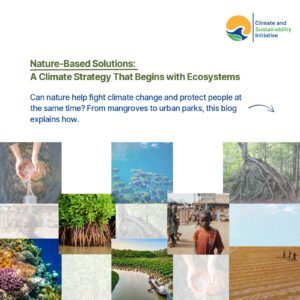In recent years, Nature-based solutions (NbS) have gained prominence as a strategic tool to address biodiversity loss, conserve natural capital,[1] and build societal and ecosystem resilience to climate change. As NbS gains traction across the international and domestic public, finance, and business policy discourse, this first blog article in our series on NbS introduces the concept – tracing its evolution, examining its usability, and why it matters.
Definition
NbS is a multifunctional, people-centric, and systemic approach to yield a positive net impact on biodiversity and provides long-term socio-economic benefits, while addressing one or more societal challenges in an inclusive and collaborative multistakeholder approach.
For many years, “Ecosystem-based adaptation” has been widely used as a precursor to NbS – albeit in the broader climate adaptation (CBD, 2009) strategy context. Ecosystem-based adaptation often involves the conservation, sustainable management, and restoration of ecosystems, such as forests, grasslands, wetlands, mangroves, and coral reefs, etc., in enhancing climate change adaptation and disaster risk (Lo, 2016; CBD, 2018) reduction. Another related concept known as “Nature climate solutions” describes climate mitigation measures that can reduce greenhouse gas (GHG) emissions from ecosystems while improving their potential to store carbon or increase natural carbon sequestration.
Though the systematic conceptualisation of NbS began in the late 2000s,[2] a formal intergovernmental consensus on the need for a formal definition was achieved only in 2022. Currently, the fifth United Nations Environment Assembly define nature-based solutions as “actions aimed at protecting, conserving, restoring, and sustainably managing natural or modified terrestrial, freshwater, coastal, and marine ecosystems, which address social, economic, and environmental challenges effectively and adaptively, while simultaneously providing human well-being, ecosystem services, resilience, and biodiversity benefits” (UNEA, 2022).
As the definition suggests, NbS aims at providing cross-sectoral solutions (to protect, manage, and restore ecosystems) ranging from urban infrastructure and water management to agriculture, forestry, coastal protection, and disaster resilience – thereby serving the multiple objectives of both environmental stewardship and development priorities. For instance, restoring mangrove forests in coastal regions reduces natural disaster risks of coastal flooding and benefits the ecosystem through providing fishing grounds, thereby supporting the local economy while also aiding carbon sequestration. The ‘Bishan-Ang Mo Kio Park’ in Singapore, the ‘Loess Plateau Restoration’ in China, the ‘Room for the River’ programme in the Netherlands, the ‘Mangrove Restoration’ in India, and the ‘Yalla Natural Climate Solutions’ in Lebanon, etc., are amongst many examples of arguably successful NbS implementation across sectors and geographies.[3]
Global policy response to NbS so far
Recognising the material risks to the 4Cs (natural capital, human capital, physical capital, and financial capital),[4] and the urgent need for systemic approaches to manage them, the Kunming–Montreal Global Biodiversity Framework explicitly called for minimising the impacts of climate change on biodiversity and building resilience through nature-based solutions (GBF, 2022).[5]
Anchoring this agenda forward, the G20 Sustainable Finance Working Group (SFWG) under Brazil’s presidency in 2024 has prioritised financing NbS, signalling a high-level policy shift toward operationalising nature-oriented finance strategies (G20 SFWG, 2024).
Is every Nature-based solution desirable in tackling climate change?
Not necessarily. A classic example of NbS can be reforestation and afforestation initiatives to address the adverse impact of deforestation on climate change, nature, and communities.[6] However, for varied reasons, even an ambitious drive of simply planting trees may not qualify as an NbS. For instance, planting non-native tree species or monocultures without active engagement of local communities can cause ecological imbalances, exacerbating water scarcity, impacting soil quality, and accelerating local biodiversity loss.
Nevertheless, NbS can be a game-changer if the solutions are designed and scaled appropriately. Research shows that NbS could provide up to 37 per cent of climate change mitigation until 2030 with likely co-benefits for biodiversity (IPBES, 2019). In carbon terms, NbS could offer at least 5 GtCO₂e (gigatonnes of carbon dioxide equivalent) per year in emission reductions and removals by 2030, with upper estimates reaching 11.7 GtCO₂e per year. An analysis of Nationally Determined Contributions (NDCs) also reveals that out of 102 updated NDCs submitted during 2021, 96 included NbS in their adaptation plans, while 45 NDCs included NbS in both their mitigation and adaptation plans (NBS Initiative, 2022). Thus, NbS are no longer fringe; they are fundamental to any credible climate, biodiversity, and sustainable development strategy.
Yet, NbS continue to face structural, financial, and operational challenges, which impede their bankability and/or scalability potential. Some of these challenges will be unpacked in upcoming articles of this series.
By Honey Karun, Economist, Climate and Sustainability Initiative (CSI). Views expressed are personal.
Endnotes
[1] The Natural Capital Protocol defines “natural capital” as the stock of renewable and nonrenewable natural resources (e.g., plants, animals, air, water, soils, minerals) that combine to yield a flow of benefits to people (Capitals Coalition n.d.).
[2] For earlier attempts to mainstream NbS, see (World Bank 2008). Biodiversity, Climate Change and Adaptation: Nature-Based Solutions from Solutions from the World Bank Portfolio; and the IUCN’s position paper on the UNFCCC COP 15 (IUCN 2022).
[3] For more examples of NbS implementation, see IUCN (n.d.).
[4] “Human capital” refers to the mental and physical attributes and capabilities of individuals that support the creation of economic value in various activities. “Physical capital” includes human-made tangible assets used in the production of goods and services. “Financial capital” encompasses the monetary assets that are available for investment, consumption, or production.
[5] See Target 8 of the Kunming–Montreal Global Biodiversity Framework. (GBF, 2022)
[6] Some of the major tree-planting initiatives in this context are the Bonn Challenge, The New York Declaration on Forests, Trillion Tree Platform, African Forest Landscape Restoration Initiative, and the EU Biodiversity Strategy 2030.
References
Capitals Coalition. (n.d.) Natural capital protocols. https://capitalscoalition.org/capitals-approach/natural-capital-protocol
G20 Sustainable Finance Working Group (SFWG). (2024). Prioritising financing of nature-based solutions. G20 Brazil Presidency. https://g20sfwg.org/news/a-snapshot-of-2024-g20-sfwg-work-as-the-brazilian-g20-presidency-concludes/
Intergovernmental Science-Policy Platform on Biodiversity and Ecosystem Services (IPBES). (2019). Summary for policymakers of the IPBES global assessment report on biodiversity and ecosystem services. https://files.ipbes.net/ipbes-web-prod-public-files/inline/files/ipbes_global_assessment_report_summary_for_policymakers.pdf
Kunming–Montreal Global Biodiversity Framework (GBF). (2022). Kunming–Montreal global biodiversity framework: Draft decision submitted by the president. (CBD/COP/15/L.25). https://www.cbd.int/doc/c/e6d3/cd1d/daf663719a03902a9b116c34/cop-15-l-25-en.pdf
Lo, V. (2016). Synthesis report on experiences with ecosystem-based approaches to climate change adaptation and disaster risk reduction. (Technical Series No.85). Convention on Biological Diversity. https://www.cbd.int/doc/publications/cbd-ts-85-en.pdf
World Bank. (2008). Biodiversity, Climate Change and Adaptation: Nature-Based Solutions from Solutions from the World Bank Portfolio; and IUCN’s position paper on the UNFCCC COP 15 (IUCN, 2009) for earlier attempts to mainstream NbS. https://documents.worldbank.org/en/publication/documents-reports/documentdetail/149141468320661795
United Nations Environment Programme and International Union for Conservation of Nature. (2021). Nature-based solutions for climate change mitigation. https://portals.iucn.org/library/node/49781
Nature-based Solutions Initiative. (2022, February 22). Revised climate pledges show enhanced ambition for nature-based solutions. https://www.naturebasedsolutionsinitiative.org/news/nbs-policy-platform-ndc-submissions/
Convention on Biological Diversity (CBD). (2009). Connecting biodiversity and climate change mitigation and adaptation: Report of the second ad hoc technical expert group on biodiversity and climate change (Technical series No. 41). https://www.cbd.int/doc/publications/cbd-ts-41-en.pdf
CBD (2018). Decision adopted by the conference of the parties to the convention on biological diversity: 14/5. Biodiversity and climate change. (CBD/COP/DEC/14/5). https://www.cbd.int/doc/decisions/cop-14/cop-14-dec-05-en.pdf
UN Environment Assembly (UNEA). (2022). Resolution UNEP/EA.5/Res.5: Nature-based solutions for supporting sustainable development. https://digitallibrary.un.org/record/3999268?ln=en&v=pdf#files


